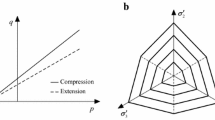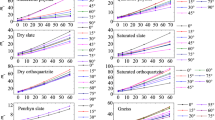Abstract
Rocks encountered at many underground construction sites are laminated and exhibit direction-dependent strength behavior. It is also a well-established fact that the strength varies in a nonlinear manner with confining pressure. There is a need of strength criterion which could capture the nonlinearity as well as the anisotropy in the triaxial strength behavior of the rocks. It is essential that the criterion should be simple and must involve minimum testing to the extent possible. Further, the parameters of the criterion should have wide acceptability among the geotechnical fraternity. In the present study, a nonlinear strength criterion for transversely isotropic rocks is presented. Critical state concept Barton (Int J Rock Mech Mining Sci Geomech Abstr 13(9):255–279, 1976) has been used to define the curvature of the criterion. With a correctly defined curvature and starting from a reference point (UCS), it is possible to accurately assess the triaxial strength for given confining pressure. An experimental study conducted on triaxial strength behavior of three types of anisotropic rocks namely phyllite, slate and orthoquartzite has been discussed. A data base comprising more than 1140 triaxial tests conducted worldwide on anisotropic rocks has been compiled. Statistical evaluation of goodness of fit of the proposed criterion to the data base has been carried out. Further, the predictive capabilities of the proposed criterion have been evaluated by determining the error in estimation of triaxial strength if only few triaxial test data are available for determining the criterion parameters. The data base has also been back analyzed to assess the critical confining pressure for anisotropic rocks. Statistically, the critical confining pressure for anisotropic rocks can be taken nearly equal to 1.25 times the maximum UCS (obtained by applying load either parallel or perpendicular to planes of anisotropy). It is concluded that reasonable estimates of the triaxial strength of anisotropic rock can be made through the proposed criterion using minimum amount of triaxial test data available.















Similar content being viewed by others
Abbreviations
- β :
-
Angle between major principal direction and planes of anisotropy
- µ β0 :
-
Coefficient of internal friction (tan ϕ β0) of the rock with planes of anisotropy oriented at angle β at low confining pressure (σ 3 → 0)
- σ 1, σ 3 :
-
Major and minor principal stresses at failure
- σ 1av :
-
Average of the experimental σ1 values for a triaxial data set
- σ 1exp σ 1cal :
-
Experimental and predicted values of the major principal stress at failure
- Ψ 2 :
-
Coefficient of accordance (COA)
- σ cβ :
-
UCS of anisotropic rock with planes of anisotropy oriented at angle of β from major principal stress direction
- σ crt :
-
Critical confining pressure for the rock
- A, B, C:
-
Constants
- A′:
-
An empirical constant which defines the shape of the strength criterion
- AAREP:
-
Average absolute relative error percentage
- c β0, ϕ β0 :
-
Mohr–Coulomb shear strength parameters obtained by conducting triaxial strength tests on rock specimens at low confining pressure (σ3 → 0)
- c, ϕ :
-
Mohr–Coulomb shear strength parameters
- l :
-
Length of rock specimen
- m :
-
Hoek–Brown criterion parameter
- N :
-
Total number of triaxial data points in the data base
- npt:
-
Number of triaxial data points in addition to the UCS for given orientation
- pe:
-
Percent error for each data point
- R 2 :
-
Regression coefficient
References
Attewell PB, Sandford MR (1974) Intrinsic shear strength of a brittle, anisotropic rock-I: experimental and mechanical interpretation. Int J Rock Mech Min Sci 11(11):423–430
Bagheripour MH, Rahgozar R, Pashnesaz H, Malekinejad M (2011) A complement to Hoek-Brown failure criterion for strength prediction in anisotropic rock. Geo-Mech Eng 3:61–81
Barton N (1976) The shear strength of rock and rock joints. Int J Rock Mech Min Sci Geomech Abstr 13(9):255–279
Barton N (2011) From empiricism, through theory, to problem solving in rock engineering: 6th Leopold Mϋller Lecture. Beijing, ISRM Congress 2011
Barton N (2013) Shear strength criteria for rock, rock joints, rockfill and rock masses: problems and some solutions. J Rock Mech Geotech Eng 5(4):249–261
Cazacu O, Cristescu ND, Shao JF, Henry JP (1998) A new failure criterion for transversely isotropic rocks. Int J Rock Mech Min Sci 35(4–5):130
Donath FA (1964) Strength variation, deformational behaviour of anisotropic rocks. In: Judid WR (ed) State of the earth in the earth’s crust. Elsevier, New York, pp 281–298
Duveau G, Shao JF (1998) A modified single plane of weakness theory for the failure of highly stratified rocks. Int J Rock Mech Min Sci 35(6):807–813
Fehimifar A (2004) Strength and deformational properties of a schist rock in Isfahan. Iranian J Scie Technol Trans B, 28:B5
Hoek E, Brown ET (1980) Empirical strength criterion for rock masses. J Geotech Eng Div ASCE 106(GT9):1013–1035
Horino FG, Ellicksone ML (1970) A method of estimating the strength of rock containing planes of weakness, no.7449. US Bureau mines, report investigation 1970
Kumar A (2006) Engineering Behaviour of anisotropic rocks, PhD thesis, Department of Civil Engineering, IIT Roorkee, Roorkee, India
Liao JJ, Yang MZ, Hsieh HY (1997) Direct tensile behavior of transversely isotropic rock. Int J Rock Mech Min Sci 34(5):837–849
McLamore R, Gray KE (1967) The mechanical behaviour of anisotropic sedimentary rocks. Trans Am Soc Mech Eng Ser B 89:62–67
Nasseri MHB, Rao KS, Ramamurthy T (2003) Anisotropic strength and deformation behaviour of Himalayan schists. Int J Rock Mech Min Sci 40:3–23
Niandou H, Shao JF, Henry JP, Fourmaintraux D (1997) Laboratory investigation of the mechanical behaviour of Tournemire shale. Int J Rock Mech Min Sci 34:3–16
Peng J, Rong G, Cai M, Wang X, Zhou C (2014) An empirical failure criterion for intact rocks. Rock Mech Rock Eng 47:347–356
Peter B, Attewell PB, Michael R, Sandford MR (1974) Intrinsic shear strength of a brittle, anisotropic rock-I: experimental and mechanical interpretation. Int J Rock Mech Min Sci 11(11):423–430
Pomeroy CD, Hobbs DW, Mahmoud A (1971) The effect of weakness plane orientation on the fracture of Barnsley hard coal by triaxial compression. Int J Rock Mech Min Sci 8:227–238
Ramamurthy T (1993) Strength and modulus response of anisotropic rocks. In: Hudson JA (ed) Compressive rock engineering principle, practice and projects, vol 1. Pergamon Press, Oxford, pp 313–329
Saroglou H, Tsiambaos G (2008) A modified Hoek-Brown failure criterion for anisotropic intact rock. Int J Rock Mech Min Sci 45:223–234
Shen J, Jimenez R, Karakus M, Xu C (2014) A simplified failure criterion for intact rocks Based on rock type and uniaxial compressive strength. Rock Mech Rock Eng 47(2):357–369
Singh M, Singh B (2005) A strength criterion based on critical state mechanics for intact rocks. Rock Mech & Rock Engg 38(3):243–248
Singh M, Singh B (2012) Modified Mohr-Coulomb criterion for non-linear triaxial and polyaxial strength of jointed rocks. Int J Rock Mech Mining Sci 51:43–52
Singh J, Ramamurthy T, Rao GV (1989) Strength anisotropies in rocks. Ind Geotech J 19(2):147–166
Singh M, Raj A, Singh B (2011) Modified Mohr-Coulomb criterion for non-linear triaxial and polyaxial strength of intact rocks. Int J Rock Mech Mining Sci 48(4):546–555
Tien YM, Kuo MC (2001) A failure criterion for transversely isotropic rocks. Int J Rock Mech Min Sci 38:399–412
Tien YM, Tsao PF (2000) Preparation and mechanical properties of artificial transversely isotropic rock. Int. J Rock Mech Mining Sci 37(6):1001–1012
Xue-Min Z, Feng Y, Jun-Sheng Y (2010) Experimental study on anisotropic strength properties of sandstone. Electron J Geotech Eng 15:1325–1335
Yaşar E (2001) Failure and failure theories for anisotropic rocks. 17th International Mining Congress and Exhibition of Turkey, pp 395–417
Zhang Z, Zhou L, Yuan Z, Sun Z (2012) Research on shear failure criterion for layered rock mass. Adv Mater Res 446–449:1491–1496
Acknowledgments
Financial support for some part of this study was received from Department of Science and Technology, New Delhi under NRDMS grant. The authors thank Dr Bhoop Singh, Director DST, New Delhi for his cooperation and support during the study.
Author information
Authors and Affiliations
Corresponding author
Electronic supplementary material
Below is the link to the electronic supplementary material.
Rights and permissions
About this article
Cite this article
Singh, M., Samadhiya, N.K., Kumar, A. et al. A nonlinear criterion for triaxial strength of inherently anisotropic rocks. Rock Mech Rock Eng 48, 1387–1405 (2015). https://doi.org/10.1007/s00603-015-0708-z
Received:
Accepted:
Published:
Issue Date:
DOI: https://doi.org/10.1007/s00603-015-0708-z




